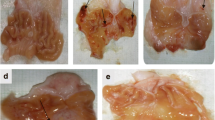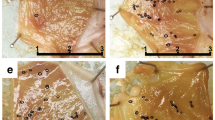Abstract
Selective COX-2 inhibitors have been shown to produce fewer gastrointestinal adverse reactionsthan classical NSAIDs. Nevertheless, these new agents may worsen and delay the healing of ex-perimentallyinduced gastric ulcers in animals. In this study, we compared the effects of a selectiveCOX-2 inhibitor (celecoxib), a preferential COX-1 inhibitor (piroxicam), and a nonnarcotic anal-gesic(metamizol) on normal gastric mucosa of rats and, on the other hand, in a setting of preexistingacute gastric lesions induced by 0.6 N hydrochloric acid. Under normal conditions, only piroxicamproduced appreciable gastric lesions. However, after acid challenge the three assayed drugs inducedsignificant macroscopic and microscopic damage. Myeloperoxidase activity as an index of neutrophilinfiltration was elevated with celecoxib and piroxicam on normal gastric mucosa. On inflamed mu-cosa,celecoxib augmented enzymatic activity at the lower dose, which was parallelled by an increasein the interleukin 1β level. Acid instillaton produced a significant rise in PGE2 content at 7 hr. Drugtreatment after acid challenge decreased prostaglandin values in all cases, although to a lesser extentthan after single drug dose administration. COX-2 mRNA expression was visible 1 hr after acidapplication, whereas COX-2 protein could only be detected at 7 hr. Piroxicam increased both ex-pressionlevels. All NSAIDs enhanced transforming growth factor α and epidermal growth factorreceptor immunoreactivity around the acid-induced lesions. It is concluded that selective COX-2inhibitors, like conventional NSAIDs, impair the healing of gastric damage, and therefore specialattention should be paid in patients with gastric pathologies.
Similar content being viewed by others
REFERENCES
Botting RM: Mechanism of action of acetaminophen: Is there a cyclooxygenase 3? Clin Infect Dis 31(S5): S202–S210, 2000
Kujubu DA, Fletcher BS, Varnum BC, Lim RW, Herschman HR: TIS10, a phorbol ester tumor promoter-inducible mRNAfrom Swiss 3T3 cells, encodes a novel prostaglandin synthase/cyclooxygenase homologue. J Biol Chem 266: 12866–12872, 1991
Sawaoka H, Tsuji S, Tsujii M, Gunawan ES, Nakama A, Takei Y, Nagano K, Matsui H, Kawano S, Hori M: Expression of cyclooxygenase-2 gene in gastric epithelium. J Clin Gastroenterol 25(Suppl 1): S105–S110, 1997
Sun WH, Tsuji S, Tsujii M, Gunawan ES, Sawaoka H, Kawai N, Iijima H, Kimura A, Kakiuchi Y, Yasumaru M, Sasaki Y, Kawano S, Hori M: Cyclooxygenase-2 inhibitors suppress epithelial cell kinetics and delay gastric wound healing in rats. J Gastroenterol Hepatol 15(7): 752–761, 2000
Botting JH: Nonsteroidal antiinflammatory agents. Drugs of Today 35(4–5): 225–235, 1999
Wallace JL, McKnight W, Reuter BK, Vergnolle N: NSAID-induced gastric damage in rats: Requirement for inhibition of both cyclooxy-genase 1 and 2. Gastroenterology 119(3): 706–714, 2000
Tanaka A, Araki H, Komoike Y, Hase S, Takeuchi K: Inhibition of both COX-1 and COX-2 is required for development of gastric damage in response to nonsteroidal antiinflammatory drugs. J Physiol Paris 95(1–6): 21–27, 2001
Bombardier C: An evidence-based evaluation of the gastrointestinal safety of coxibs. Am J Cardiol 89(6): 3–9, 2002
Mizuno H, Sakamoto C, Matsuda K, Wada K, Uchida T, Noguchi H, Akamatsu T, Kasuga M: Induction of cyclooxygenase 2 in gastric mucosal lesions and its inhibition by the specific antagonist delays healing in mice. Gastroenterology 112: 387–397, 1997
Laudanno OM, Cesolari JA, Esnarriaga J, Rista L, Piombo G, Maglione C, Aramberry L, Sambrano J, Godoy A, Rocaspana A: Gastrointestinal damage induced by celecoxib and rofecoxib in rats. Dig Dis Sci 46(4): 779–784, 2001
Tibble J, Sigthorsson G, Caldwell C, Palmer RH, Bjarnason I: Effects of NSAIDs on cryoprobe-induced gastric ulcer healing in rats. Aliment Pharmacol Ther 15(12): 2001–2008, 2001
Colville-Nash PR, Gilroy DW: Potential adverse effects of cyclooxygenase-2 inhibition: Evidence from animal models of inflammation. BioDrugs 15(1): 1–9, 2001
Sun WH, Tsuji S, Tsuji M, Gunawan ES, Kawai N, Kimura A, Kakiuchi Y, Yasumaru M, Iijima H, Okuda Y, Sasaki Y, Hori M, Kawano S: Induction of cyclooxgenase-2 in rat gastric mucosa by rebamipide, a mucoprotective agent. J Pharmacol Exp Ther 295(2): 447–452, 2000
Berenguer B, Alarcón de la Lastra C, Moreno FJ, Martín MJ: Chronic gastric ulcer healing in rats subjected to selective and non-selective cyclooxygenase-2 inhibitors. Eur J Pharmacol 442: 125–135, 2002
Villegas I, Martín MJ, La Casa C, Motilva V, Alarcón de la Lastra C: Effects of oxicam inhibitors of cyclooxygenase on oxidative stress generation in rat gastric mucosa. A comparative study. Free Rad Res 36(7): 769–777, 2002
Sánchez S, Martín MJ, Ortiz P, Motilva V, Alarcón de la Lastra C: Effects of dipyrone on inflammatory infiltration and oxidative metabolism in gastric mucosa: Comparison with acetaminophen and diclofenac. Dig Dis Sci 47(6): 1389–1398, 2002
Grisham MB, Beniot JN, Granger DN: Assessement of leucocyte involvement during ischemia and reperfusion on the intestine. In Methods in Enzymology. Oxygen Radicals in Biological Systems.L Packer, AE Glazer (eds). San Diego, Academic Press, 1990, pp 729–741
Chomcynsky P, Sacchi N: Single-step method of RNA isolation by acid guanidium thiocyanate-phenol-chloroform extraction. Anal Biochem 162: 156–159, 1987
Gretzer B, Ehrlich K, Maricic N, Lambrecht N, Respondek M, Peskar BM: Selective cyclooxygenase-2 inhibitors and their influence on the protective effect of a mild irritant in the rat stomach. Br J Pharmacol 123: 927–935, 1998
Schmassmann A, Peskar BM, Stettler C: Effects of inhibition of prostaglandin endoperoxide synthase-2 in chronic gastro-intestinal ulcer models in rats. Br J Pharmacol 123: 795–804, 1998
Gretzer B, Maricic N, Respondek M, Schuligoi R, Peskar BM: Effects of specific inhibition of cyclooxygenase-2 in the rat stomach with normal mucosa and after acid challenge. Br J Pharmacol 132(7): 1565–1573, 2001
Gretzer B, Maricic N, Schuligoi R, Peskar BM: Effect of SC-560, a selective cyclooxygenase (COX)-1 inhibitor, and its modification by COX-2 inhibition in the rat stomach. Gastroenerology 118(4): A240, 2000
Peskar BM, Maricic N, Gretzer B, Schuligoi R, Schmassmann A: Role of cyclooxygenase-2 in gastric mucosal defense. Life Sci 69(25–26): 2993–3003, 2001
Kishimoto Y, Wada K, Nakamoto K, Kawasaki H, Hasegawa J: Quantitative analysis of cyclooxygenase-2 gene expression on acute gastric injury induced by ischemia/reperfusion in rats. Life Sci 60: 127–133, 1998
Tarnawski A: Cellular and molecular mechanisms of ulcer healing. Drugs Today 33(10): 697–706, 1997
Tarnawski A, Stachura J, Durbin T, Sarfeh IJ, Gergely H: Increased expression of epidermal growth factor receptor during gastric ulcer healing in rats. Gastroenterology 102: 695–698, 1992
Konturek SJ, Brzozowski T, Dembinski A: Gastric protective and ulcer-healing action of epidermal growth factor. In Advances in Drug Therapy of Gastrointestinal Ulceration. A Garner, BJR Whittle (eds). New York, Wiley-Interscience, 1989, pp 261–273
Terano A, Sakata-Horie K, Shimada T, Hiraishi H, Yoshiura K, Yoneda M, Takahashi M, Fujimori T: The role of cellular migration in the repair process of gastric epithelial cells. Life Sci 69(25–26): 3083–3089, 2001
Schmassmann A: Mechanisms of ulcer healing and effects of non-steroidal antiinflammatory drugs. Am J Med 104(3A): 43S–51S, 1998
Takahashi S, Kobahashi N, Okabe S: Regulation by endogenous interleukin-1 of mRNA expression of healing-related factors in gastric ulcers in rats. J Pharmacol Exp Ther 291(2): 634–641, 1999
Brzozowski T, Konturek PC, Konturek SJ, Drozdowicz D, Kwiecien S, Pajdo R, Bielanski W, Hahn EG: Role of gastric acid secretion in progression of acute gastric erosions induced by ischemia-reperfusion into gastric ulcers. Eur J Pharmacol 398: 147–158, 2000
Jüni P, Rutjes AWS, Dieppe PA: Are selective COX-2 inhibitors superior to traditional non steroidal anti-inflammatory drugs? Adequate analysis of the CLASS trial indicates that this may not be the case. Br Med J 324: 287–288, 2002
Boers M: Seminal pharmaceutical trials: Maintaining masking in analysis. Lancet 360: 100–101, 2002
Author information
Authors and Affiliations
Rights and permissions
About this article
Cite this article
Berenguer, B., De la Lastra, C.A., Motilva, V. et al. Effects of Celecoxib on Acid-Challenged Gastric Mucosa of Rats: Comparison with Metamizol and Piroxicam. Dig Dis Sci 49, 937–947 (2004). https://doi.org/10.1023/B:DDAS.0000034552.20917.5e
Issue Date:
DOI: https://doi.org/10.1023/B:DDAS.0000034552.20917.5e




